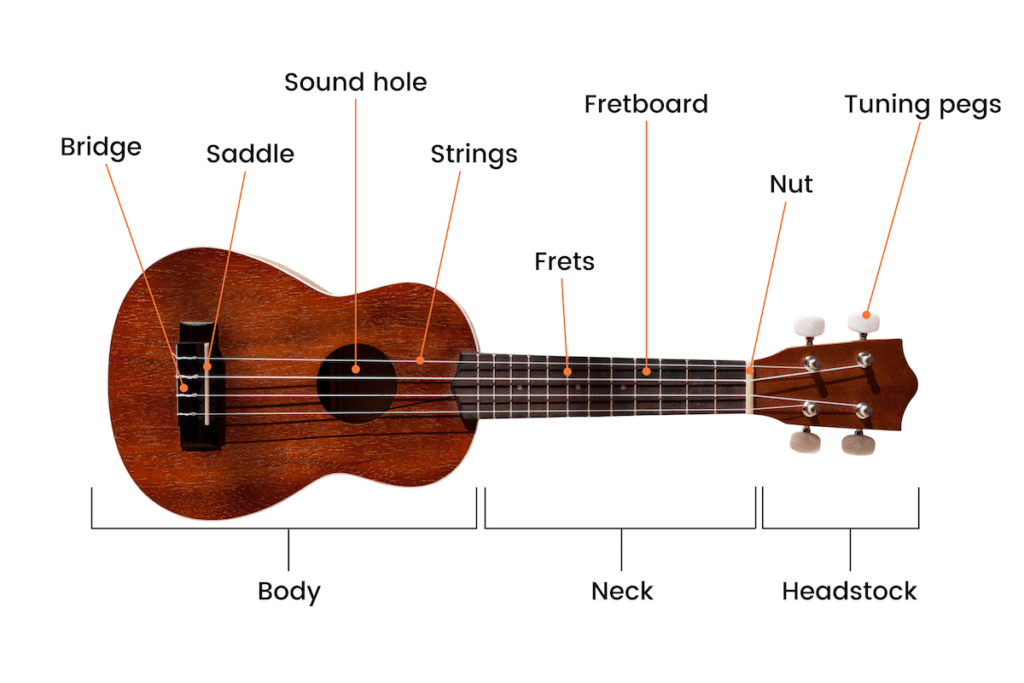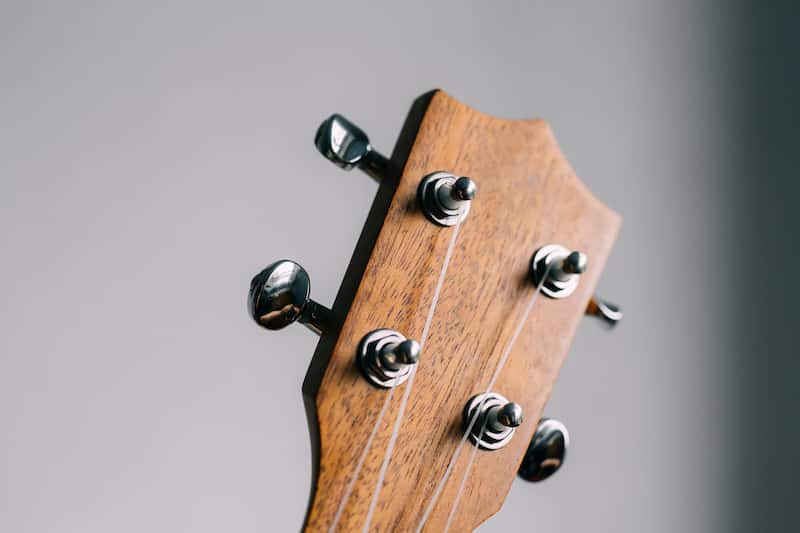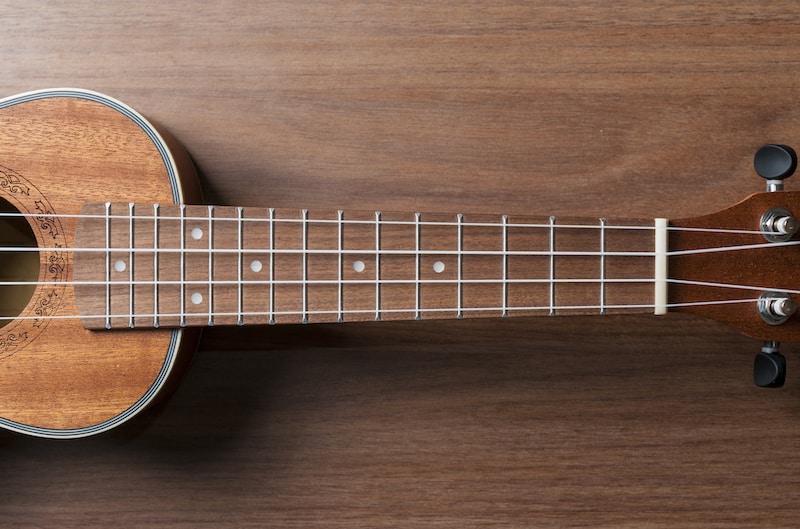Although not originally from there, the ukulele is definitely considered by most to be a traditional Hawaiian instrument. It rose to popularity because of its portable size and bright sounds. In the US alone, there were reportedly over 1.5 million ukuleles sold in 2020!
You can find ukuleles at a reasonably affordable price compared to other instruments, and it’s easy to learn a few basic chords, which is why it makes an excellent instrument for beginners who don’t have much experience in playing music.
In this article, we’ll go into further detail about the different parts of the ukulele so that you’ll get a better picture of how it works and how to play it.
Anatomy of the Ukulele

Ukuleles come in a number of different shapes and sizes, but there are four main kinds of ukuleles (although there are lots more variations).
- soprano
- concert
- tenor
- baritone
Although they’re all slightly different in terms of size and sound, they all share the same three main parts, which are the head (or headstock), the neck, and the body.
Knowing the parts of a ukulele will help you understand how to play it and best care for it.
The Headstock

The headstock, or head, is the part that’s the furthest away from the ukulele’s body and is typically made out of wood or plastic.
The headstock is important because it supports the tuners.
It must be a sturdy piece that securely attaches to the neck because it must hold the tension of the strings wound around the tuners.
Headstocks come in two main styles–slotted or solid.
These styles change the positioning of the tuners.
However, they don’t significantly affect the ukulele’s tone and are more of an aesthetic preference.
Tuning Pegs
The tuners pegs on a ukulele as the name suggests is the part that allows you to tune the strings.
They have a few names and you might see them called pegs, tuners, tuning heads, tuning keys, or machine heads but all are referring to the same thing.
The tuners are four pegs or keys that are attached to the headstock, and it has the ukulele’s strings wound around it.
The musician then turns the keys, which either loosens or tightens the tension of the ukulele’s strings lowering or raising the pitch of the string.
They are two common types of tuners: friction tuners and geared tuners.
Friction tuners rest behind the headstock and keep the strings in tune with their grip.
Geared tuners are on the sides of the headstock, and they have gears that help keep the strings in tune.
The Neck

The neck is a long, thin piece of wood that connects the headstock to the body of the ukulele.
Most ukuleles have their necks made of wood but some cheap ukuleles can have plastic necks.
The neck is the part that the musician grips with their non-strumming hand and plays chords and notes with their fingers while gripping the back with their thumb.
The back of the neck is also curved so that your hand can hold it comfortably.
Nut
The nut is a thin ridge that lays perpendicularly between the headstock and neck of the ukulele.
It’s a small, unnoticeable piece, but it plays an important role.
The neck has four grooves carved into it which the strings sit in so that they don’t slide around and are spaced correctly with enough distance apart from each other.
As well as controlling spacing between the strings, the nut also lifts the ukulele’s strings a few millimeters above the fretboard so that players can press the strings to play different notes.
This is called the action – the further the strings are from the fretboard, the higher the action and vice versa, the closer they are, the lower the action.
A ukulele wouldn’t be able to make a sound without the nut!
Fretboard
The fretboard, or fingerboard, is one solid piece of wood that sits on top of the neck and lies beneath the strings.
It’s the part that the musician uses their left hand to push down on to produce different notes and chords.
The ukulele produces a different note depending on where you press the string down on the fretboard.
The closer the note is to the body, the higher the pitch and vice versa, the further from the body, the lower the pitch of the note.
Frets
On top of the fretboard, you’ll find the frets which are thin bars (usually made from metal) that lie perpendicularly against the fretboard.
The frets are slightly raised, but they aren’t the same height as the nut.
They get hammered onto the fretboard at specific spots so that the musician knows where to press their fingers down to play specific notes.
They also stop sound from playing and if you were to press a string directly on top of a fret, it wouldn’t produce a clear sound.
Unlike stringed instruments without frets, such as a cello or a violin, you can only play notes a half step apart on a ukulele.
Fret Space and Markers
The fret spaces are the spots in between each fret and these are where you press your fingers to produce a clear sound.
When you play more than one note in a fret space on different strings at the same time, you can play a chord.
You’ll also notice the fret markers which lie on certain parts of the fretboard.
They’re often dots, but they can also vary in shapes and colors.
The purpose of the fret marker is to help ukulele players find specific notes as they provide a reference.
Their placement is helpful when the player has to slide their hand a greater distance from the lower end of the fretboard towards the body of the ukulele.
You can typically find the fret markers on the third, fifth, seventh, tenth, and twelfth fret spaces.
Strings

The strings run from the tuning pegs to the bridge of a ukulele and are typically made of nylon.
But, bigger ukuleles, like the tenor and baritone, can have nylon or metal-wound strings.
Metal-wound strings have a fuller sound and tend to stray away from the bright sounds of a traditional ukulele.
Most ukuleles have four strings that are tuned to the pitches G, C, E, A.
But, unlike lots of other string instruments like the guitar or banjo, the strings of the ukulele are not in order of pitch.
The C string is the lowest-pitched note, followed by E, G, and then A.
This is determined by the thickness of the string with the thicker the string, the lower the pitch of the note, and the thinner the string, the higher the pitch of the note that sounds.
The Body
The body is the largest and most prominent part of the ukulele and is typically made out of woods like mahogany, spruce, or koa, but sometimes plastic on lower-end models.
When the strings are played, it causes the body to vibrate, which then is amplified by the resonance chamber inside the body.
The front of the ukulele is called the soundboard, and it helps to amplify the sound of the ukulele’s strings.
It has many shapes and sizes, which also affect the sound and tone of the ukulele.
The type of wood used also contributes to the kind of sound the ukulele will make.
For example, ukuleles from Hawaii mostly use native koa wood, which produces a very bright sound.
Meanwhile, ukuleles made of mahogany have a more warm and mellow sound.
Sound Hole
The sound hole is the large hole in the body of the ukulele that the strings run on top of.
It helps amplify the sound of the strings when they are plucked or strummed in much the same way as the f-holes do on an instrument like the violin or cello.
The sound is loudest when you pluck directly above the sound hole, and the sound becomes quieter as you pluck further away from it.
Some sound holes might have a rosette around the rim.
The original purpose of a rosette was to keep the wood of the body from cracking.
However, with modern technology, this type of cracking has become a rare occurrence and nowadays the rosette just plays an aesthetic role.
Bridge
The bridge is a strip of wood, plastic, or sometimes bone that is located lower on the body just beneath the sound hole.
Its job is to help the vibrations of the strings when they’re played travel to the body of the ukulele which amplifies the sound.
There are four popular types of bridges:
- Tie-bar bridge
- Slotted bridge
- Pin bridge
- String through bridge
The type of bridge doesn’t significantly affect the sound quality of the strings.
They’re more of a matter of aesthetic and personal preference.
For example, the tie-bar bridge requires some specific knotting that can be a little tricky for beginner ukulele players.
However, it has a more traditional look.
Pin bridges are the easiest to replace strings because all you have to do is slide the string through the bridge holes without worrying about tying knots.
Saddle
And lastly, the saddle sits above the bridge.
It has a similar purpose as the nut on the head of the ukulele as it keeps the strings separated so they don’t touch each other.
It has small grooves cut into it so they don’t move around too much
It also helps keep the strings leveled at the same height across the whole ukulele.
Summing up the Ukulele’s Parts
These are all the essential parts of a ukulele. You might get lost in the details of the different parts, such as wood and string type.
However, if you don’t get sucked up into the details, it’s a straightforward instrument at its barebones, so it’s relatively easy to pick up.
Once you start learning to play the ukulele, you can discover your sound and tone preferences and do further research from there.
Then, the details will naturally become less intimidating and more of a fun endeavor.

